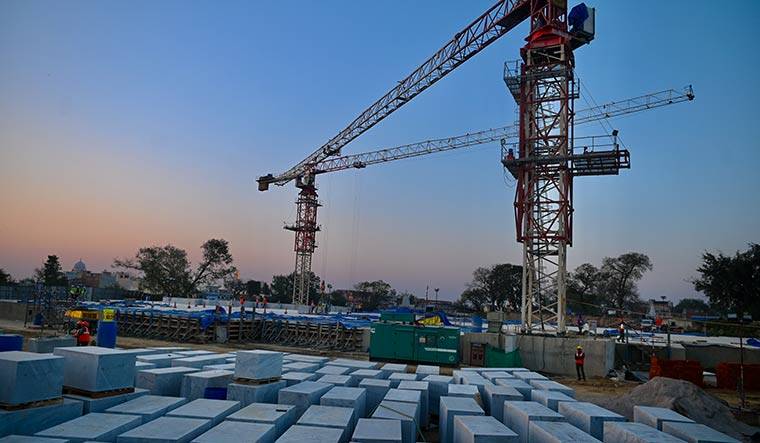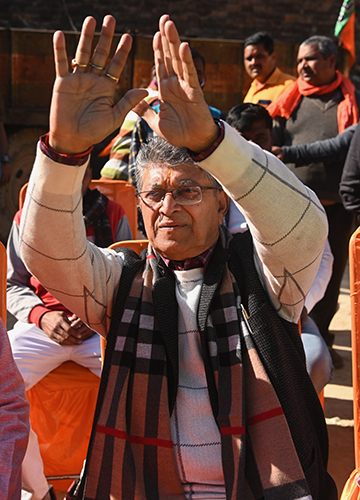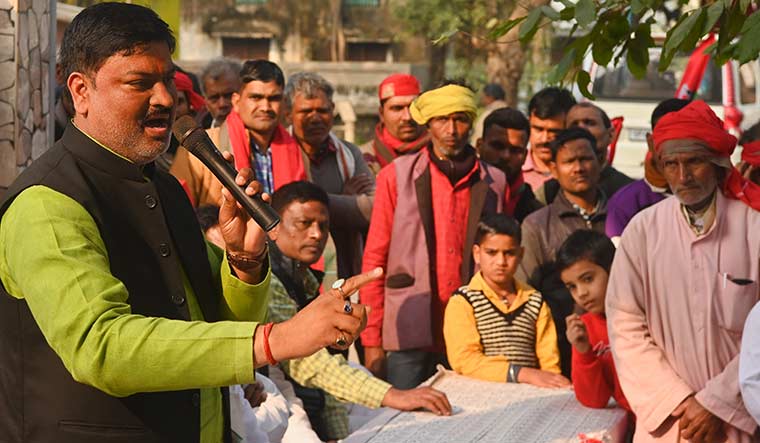Hazari Das Baba’s right eye will hold your gaze. It resembles a cloudy sky; shades lighter than his left, which is as dark as the night sky. “I think the colour of the right eye is changing because of bleeding,” says Das, 70. “I can see properly only through one eye now.” His left shoulder is damaged, too, he reveals. And, it has little to do with age.
Das lives in the regional office of the Vishva Hindu Parishad (VHP) in Karsevakpuram in Ayodhya, and has witnessed the changing contours of the Ram Mandir issue over the decades. He is the caretaker of the hall in the spacious office that houses the miniature model of the Ram Janmabhoomi temple. But Das was no mere spectator—he was one of the many kar sevaks who tried to reach the Babri Masjid in 1990.
A native of Shahjahanpur district, he claims to have escaped the police firing that killed several people. But he ran out of luck in 1992, when the mosque was demolished. “I fell from the mosque structure and the debris landed on me,” he recalls. That fall damaged his eye and shoulder and landed him in hospital and eventually behind bars.
It did not damage his reputation though—over the years, devotees flocking the Ram Janmabhoomi site started calling him ‘baba’. The Ram Mandir issue has been central to Ayodhya and its residents for decades, and in an election year it is no different. But will it bring in votes?
Finding answers in Uttar Pradesh is like finding your way through a maze. As we leave town to chase leaders and gauge the mood of the voters, we melt into the rural landscape. Sitting MLA Ved Prakash Gupta of the BJP is scheduled to attend a public meeting in Badokhar village. Ten kilometres from the Ayodhya-Faizabad highway, the scenery changes to lush green fields and narrow roads. We pass village after village, only to realise that we have lost our way. We seek directions from a youngster, only to be told, “It is a Muslim village and I am a Hindu. I don’t go there much.” All he does is point towards a road.
We take the road that could best accommodate a medium-sized car. A sharp left turn later, we come up behind an SUV that has blocked the road. After incessant honking, a group of youngsters tells us, “The vehicle’s owner is busy getting his hair cut in a nearby salon. He might take time.” They recommend turning back and taking another route, which leads us not to the village but to a pond.
We give up on finding Badokhar village, and instead decide on meeting Gupta at Dadera village, one of his last stops for the day. We spot a few dejected faces there. Their grouse? Stray cows trespassing into their fields and destroying crops. Such incidents have been on the rise ever since the state government passed the law banning cow slaughter. Ageing cows, who were earlier sent to slaughterhouses, are now abandoned on the streets and open fields.
Dadera village, with 1,800 voters, is a BJP bastion. And, villagers are hoping the party will come up with a solution soon. The meeting is being held outside Sayyam Srivastav’s house. “Crops in two of my 20-bighas were destroyed by cows,” laments the wheat and sugarcane farmer. Others speak of losing sleep and about the cost of employing guards at their fields. Some had to spend on fencing their farms with barbed wire. Despite all this, none of them will vote against the BJP.
Gupta arrives and speaks to a gathering of 50-odd people. He highlights the BJP’s development work in the constituency, stresses on the party fulfilling the promise of the Ram temple and pitches it as a tourist and spiritual destination that can spur employment. And, he has a plan in place for stray cows. “We have already made arrangements to transport them to the nearest cow shelters,” he tells THE WEEK. “Our plan in the near future is to start a cow shelter in every gram sabha for ageing cows.”
A few kilometres away, the Kanha Gau Shala takes in stray cows from nearby villages based on complaints. Trucks keep plying in and out of the cow shelter. Unlike the cows though, we are denied entry.
Travelling a few kilometres from Dadera, saffron gives way to a darker shade. A corner of the main road in Rasoolabad village is painted red. Men in red turbans sit on red chairs in front of a table covered in red cloth. It is the inauguration of the local office of the Samajwadi Party. Its Ayodhya candidate—former minister Tej Narayan aka Pawan Pandey—is here. As soon as he steps out of the SUV, he walks towards the crowd, greeting youngsters with folded hands and touching the feet of the elderly. He chews on the rose petals from a garland as a string of big and small leaders speak in support of him. When his turn comes, he tailors his speech to each caste. He recalls the Hathras rape case while addressing dalits, and talks about “fake encounters” to the Brahmins, Nishads and Yadavs. And to the BJP, he says, “Do not forget that I am a bigger Hindu than you. I am a Brahmin and a Pandey.” He is hopeful that the Brahmin card will see him through.
Pandey tells THE WEEK that people are unhappy with the increase in municipal tax and that his party will bring it down if voted to power. Likewise, he assures relief to troubled farmers over the stray cow issue.
Even among the din of election, the Sarayu in Ayodhya flows unperturbed. There is no dip in the visitors she gets on her ghats; the pujas and boat rides continue as usual. The cows come here, too, and giving them company are lifeless teddy bears propped on the gunwales of boats. Step away from the Sarayu, and one will encounter monkeys—hordes of them.
But what is Ayodhya without its temples—its narrow lanes are dotted with old, colourful temples. And, it is in these temples and among those who run them that a poll narrative emerges. The Ram Janmabhoomi Nyas (trust), the all-powerful body entrusted with the construction of the Ram temple in Ayodhya, has 15 members that includes Hindu monks and representatives of Hindu groups. One of them is Mahant Dinendra Das, chief priest of the Nirmohi Akhara, which was one of the litigants in the Ram Mandir case.
To its right, the Nirmohi Akhara has residential quarters for about a dozen people, including youngsters here to train in the religious way of life. The mahant, clad in a red sweater and yellow dhoti, meets us. His salt-and-pepper beard makes it hard to decipher his expressions. His response to a dozen questions are a mere few words, implying everything is fine, and a warm smile. Dinendra, who joined the akhara as a student in 1978, was elevated to a mahant in 2017. He admittedly does not read newspapers. But what about polls and politics? He flashes a smile and says people, irrespective of parties, come to meet him.
Wading past slippery and muddy roads, we proceed towards Karsevakpuram—the hub of the temple construction activity. Champat Rai, general secretary of the trust, lives inside the VHP campus. He is unquestionably one of the most active and powerful figures within the trust, and is also the VHP’s global vice president. We finally get to meet him after a few unsuccessful attempts. “The progress of the Ram Janmabhoomi temple is satisfactory,” he says. “People may visit and worship at the temple by 2023, but there is no deadline for the completion of the temple.”
Once the temple is completed, they expect a traffic of 50,000 devotees on a daily basis. He, however, refuses to comment on donations received or the controversy surrounding purchase of lands. He does not entertain questions about elections, either. But he does speak a few words for the critics of opposition parties. “They are all sympathisers,” Rai says. “They are only criticising due to political reasons.”
Karsevakpuram also houses the oldest workshop of Ram Janmabhoomi temple. In every corner of the workshop, one can find huge beige-coloured stone blocks with traditional temple carvings. A few visitors have written holy words or phrases on the stones with chalk and these would eventually be transported to the temple site. There was also a dedicated section for hundreds of stacked old bricks with “Shri Ram” written on them in different languages, fonts and prints. In another corner, a group of artisans from Rajasthan chisel motifs on a huge block. While the granite is being shipped from Karnataka, stones and Makrana marble are being brought from Rajasthan for the temple construction.
The temple construction site is heavily guarded. The inclined narrow lanes lead to the current Ram Lalla temple, adjoining the site. As we step onto the land that was in dispute for almost the entire period of independent India, construction is in full swing. Huge cranes carry granite blocks from one end of the site to the temple area. The foundation is complete and the workers are engaged in raising the plinth. An estimated 17,000 blocks will be required for this exercise. The two-storied temple and boundary wall will cover eight acres.
Outside the temple site, there is a line-up of more temples and shops selling sweets and religious items. Heera Lal owns a general store close to the temple site. He is upset about losing part of his shop to the proposed road expansion plans. “What will happen to my livelihood and regular income? I am unhappy with what this government is doing in the name of beautification of holy structure,” he says. In the recent past, many traders like him have openly protested the expansion plans. But the BJP government refuses to budge.
Also read
- 'BJP scores big': Election results so far in Goa, Punjab, UP and Uttarakhand
- UP polls: Akhilesh Yadav's solo fight to recapture Lucknow
- Akhilesh Yadav interview: I have learnt how to defeat the BJP
- Dalit identity has become more assertive, but Mayawati has moved at a snail's pace
- Manifestos are fake; we do what we say: BSP’s Satish Chandra Misra
- No samajwad in Samajwadi Party: Aparna Yadav, BJP
Traders apart, a few priests are also unhappy with the BJP. “Ayodhya has always been a holy place,” says the priest of a small temple. “So, what great work has the BJP done? For me, the candidate is important and I will vote for the person who is accessible. Samajwadi Party’s Pandey is approachable and a hard worker.”
The Baudi temple, located in a lane in Tulsi Nagar, resembles a mansion with its exterior floral designs. Inside, the walls of the 300-year-old temple are painted a vibrant green and the stones depict beautiful paintings from the Ramayan. The artwork seems to have a touch of Roman and Oriental impressions. Temple caretaker Phool Prasad Das informs that the stones were imported from Japan, Germany and other countries by the then king.
Das lives in the temple premises with a couple of other sanyasis. Unlike other priests, he does not shy from talking about politics. “[Chief Minister] Yogi [Adityanath] comes in a chopper, waves hands and leaves,” he says. “They are using Ayodhya only for hype. We will be happy if the BJP leaders mingle with us and take care of every temple and priest and not just focus on one project.”
For the minorities and the common public, civic and employment issues seem to be the priorities. On Railway Extension road, Iqbal Ansari sits on a sofa placed unusually in an open garage. He is the son of Hashim Ansari, the oldest litigant in the Babri Masjid case. Guarded by two armed policemen, he consoles a man who lost his brother recently. “Hindus and Muslims alike come to me,” says Ansari. “I help them in whatever way I can.” He takes pride in talking about the communal harmony in Ayodhya and how the temple issue never created a discord among local residents. His Hindu friend joins in, saying, “We have never even celebrated Ramleela here.”
The men say that the Ayodhya issue had more resonance nationally and the project was being piloted by outsiders. So, what matters for the local residents? “Look at the condition of the roads,” says Ansari. “There is filth everywhere and the city needs to be cleaner. The unemployment rate is high. Take a tour of the city and you will see only poverty. These are the issues that need to be addressed.”
While all candidates claim that they have Lord Ram’s blessings, it remains to be seen who gets the voters’ blessings this poll season.




